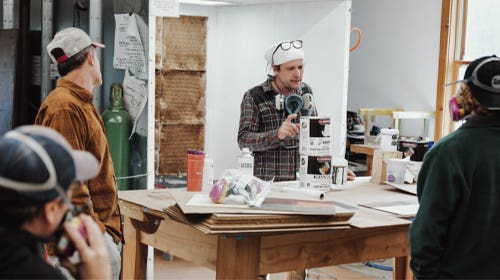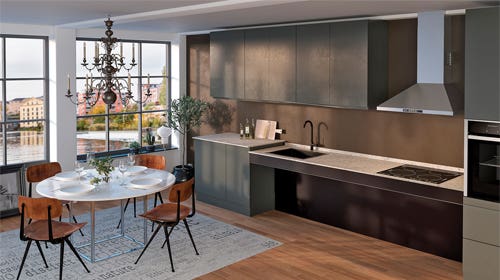Windswept urban tree reborn as fine furniture
A windstorm delivering gusts approaching 60 miles per hours battered Chicago’s western suburbs in March 2016, uprooting an 80’-tall white oak tree.
A windstorm delivering gusts approaching 60 miles per hours battered Chicago’s western suburbs in March 2016, uprooting an 80’-tall white oak tree. The Village of Riverside dispatched an emergency crew to clear the fallen tree that was blocking a roadway. A chainsaw whirred into action slicing away branches and dividing the tree’s trunk into manageable chunks so a front-end loader could lug them to the roadside.
End of story? Not by a long shot.
Eighteen months after the howling winds sent the tree crashing down, the oak’s legacy is immortalized in three Arts and Crafts-styled desks used for Riverside village and township board of trustee meetings.
The story of the tree’s conversion into fine furniture instead of meeting the usual fate of being chipped and land filled illustrates what can happen when a municipal forester, sawyer and custom woodworker come together with a shared vision to put a stricken community tree to its best possible use. The Riverside oak’s tale is but one of many to emerge as the urban wood movement gains momentum not only in Illinois but across the United States and Canada.
Mike Collins, village forester of Riverside, was a first responder to the downed tree. He’s the one who quickly grabbed a chainsaw intent on “getting the road cleared.”
“As I cut away most of the branches, I could see a beautiful, clean trunk.” Collins says. “That’s when it dawned on me that it had a pretty nice log that could be milled and made into something special.”
To maximize the trunk’s lumber potential, Collins cut a 16’ log extending about 2’ from the bottom on up. “I could see that the tree suffered from Armillaria root rot.” Collins says. “I could literally stick my hand up the bottom of the tree and pull out wood fiber. The tree was destined to fail. The winds just put the final nail in the coffin.”
Collins later counted the rings of the 30” diameter log and determined the oak was at least 160 years old. That dates the tree to the time when famed landscape architect Frederick Law Olmstead was commissioned in 1869 to design what is considered the first planned community in the nation. The Riverside Landscape Architecture District that Olmstead created was designated as a National Historic Landmark in 1970.
Developing an Urban Wood Network
The odyssey of the historic Riverside oak’s reincarnation as fine furniture shows how cultivating an urban wood network can pay-off big dividends.
A few years earlier, Collins spoke with Edith Makra, then chairperson of the Illinois Wood Utilization Team (IL WUT), at a regional meeting of municipal managers. IL WUT consists of arborists, sawyers, woodworkers and other stakeholders who advocate repurposing felled community trees to their highest potential. After telling her about Riverside’s burgeoning pile of old-growth ash logs salvaged from trees killed by the emerald ash borer, Makra put Collins in touch with Don Peterson, executive director of the Sustainable Resources Institute. Peterson, in turn, introduced Collins to Dan DeSerto, owner of Bull Valley Hardwood in Woodstock, Ill., which operates a hardwood lumber operation heavily focused on sourcing logs from local urban and other non-commercial forests.
DeSerto purchased and hauled more than two dozen of Riverside’s ash logs for $1,600, while sparing the village with disposal costs. “It was not incredibly profitable,” Collins says, “but it gave us a new source of funds to funnel into tree planting. We were able to turn a little bit of that lemon into lemonade.”
The experience of working with Bull Valley Hardwood was top of mind when Collins shared his vision of having the oak log made into furniture with Village Manager Jessica Frances. Frances says it didn’t take much convincing to gain the support of village board to budget funds for the project. “We viewed this as an extension of our goal to be more sustainable,” Frances says. “Village president Ben Sells was very excited at the thought of having tables made from a tree that was part of Riverside’s history.”
Getting the green light from the board of trustees was made all the easier by the price tag: $500 for Bull Valley Hardwood to mill the log and $9,500 to have three pedestal desks custom crafted by Paul Meyer of Woodstock Woodworks & Studio, who DeSerto recommended for the project. “The cost could easily have been at least double that,” Collins says, “but Paul and Dan donated a lot of time and effort to this cause.”
“The Riverside oak project was my first that involved using locally sourced wood,” says Meyer, who quit his long-standing gig as a high school woodworking and drafting teacher to pursue his passion of making fine furniture for a living. “I loved the fact that the wood has an historical context and decided that an Arts and Crafts style design would be appropriate.”
Oak log meets the Dominator
With all systems go, the urban oak log was hauled to Bull Valley Hardwood, where it was slated for a date with a Baker Dominator sawmill. “The Dominator has a rating of up to 9,000 board feet a day,” DeSerto says. “It’s probably the highest capacity mill in Illinois right now, certainly in northern Illinois.”
Bull Valley Hardwood’s facility also features three high-efficiency Nyle dehumidification kilns. The bulk of logs processed into lumber by the company are obtained from municipal and county sources, including more than 100 semi loads of wood from the Cook County Forest Preserve.
Where Collins saw beauty in the old-growth oak’s trunk, DeSerto saw less grandness as he prepared the log for milling. “This technically was not a saw log,” DeSerto says. “A saw log generally has two or three sides clear. In our prep work we took a chainsaw to the log and trimmed a lot of nubs off of it so that we could physically get it on the mill. There were a lot of knots.”
“Growing in an urban parkway environment, sunlight reaches all sides of the tree,” Collins observes. “But in a forest setting, the limbs would be shed naturally over time by competition for light. This would reduce the number of knots.”
The oak log yielded about 700 bf of 8/4 lumber with each board measuring about 16’ long and ranging from 8” to 26” wide.
After the boards were dried, they were delivered knots and all to Meyer’s shop. Nonplussed by the woods’ many significant character flaws, Meyer forged ahead and went the extra mile to make the wood worthy of fine furniture.
“I’m used to adding a lot of details and making a lot changes as I’m working,” Meyer says. To eliminate knots in the wood, Meyer sliced veneer to about 3/32”. “Each pedestal of the tables probably has about 100 pieces because the panels behind the grids are veneered,” Meyer says. “I took a two-inch-wide board and cut 12 to 14 pieces of veneer out with a Laguna band saw and sanded them on a drum sander. Then I matched them up and glued them on Baltic birch plywood on both sides. Each of these panels probably has five pieces on one side and three on the other. I used lap joints so that they would never fall apart.”
Meyer’s meticulous attention to detail, from slicing veneer strips to the use of mortise-and-tenon joinery, was incredibly time consuming. But the time spent on craft operations paled in comparison to the estimated 200 hours “sanding everything to make sure it was nice and smooth and everything fit perfectly.” All told, he estimates that he invested about 450 hours to produce the three tables.
Whereas Meyer employed traditional woodworking tools – portable routers, table saw, etc., - the logo on the front panel of the center table was etched by a Felder CNC router at Bull Valley’s shop. A 1/32” bit was used to rout a mere 2/100 of an inch into the surface of the wood – deep enough to create the Riverside’s delicate logo without risking tear out. “It was perfect,” says Meyer, who hand painted the routed logo with black paint, a job that took about six hours.
For the finishing touch, Meyer called on a friend to spray the tables with a pre-catalyzed lacquer to provide extra durability in a public space. Before the finish was applied, though, Meyer fumed the wood with ammonia hydroxide to darken it and highlight the oak grain pattern. “I put the tables in a big sealed plastic tent for about eight hours. As the ammonia evaporated, it reacted with the tannins in the white oak. The nice thing is that when you fume something, it doesn’t raise the grain. You don’t have additional sanding and the color change goes fairly deep – about 1/16”. On the end grain it goes about 1/8” in so if you ever scratch the table, you are not going to go through the color,” he says.
A happy customer
“I give the Illinois Wood Utilization Team a lot of credit for planting the seed for this idea,” Collins says. “As an urban forester, hearing stories about urban and community trees being repurposed is inspiring. Our village got one helluva a bargain. The finished pieces are a testament to Paul’s and Dan’s attention to detail. It’s amazing that with their help we have been able to make a connection with history.”
Frances seconds Collins’ sentiment. “What Paul created is just phenomenal. These tables will be utilized by our village and township for many years to come.”
DeSerto is hopeful that Riverside’s historic oak reclamation project sparks a trend. “I’m hoping that this gets other municipalities thinking about the good stuff that can come out of their fallen trees beyond mulch and firewood.”
This article originally appeared in the June 2018 issue.







